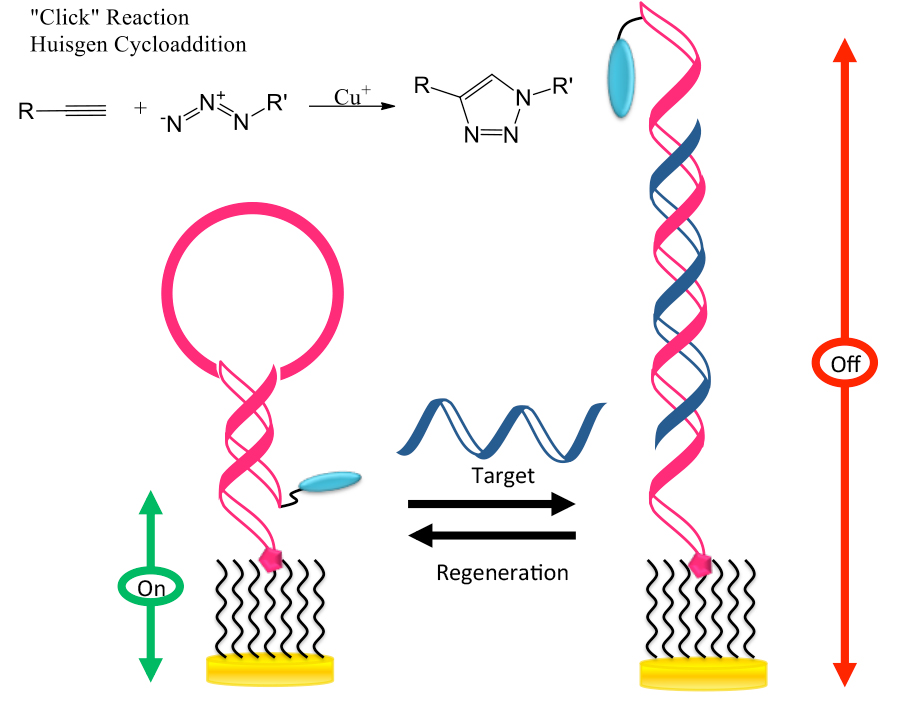Research Area 5: Nanohybrid Functional Materials Collaborative Research
Center for Nanohybrid Functional Materials (CNFM) targets the discovery and exploitation of new sensing principles based upon the combination of 3D ordered nanostructures and chemical or biochemical sensing elements. Our Lab participates in three defined research areas within CNFM.

Area I: In this research area, the focus is on developing new surface functionalization strategies for biosensing applications. Recently, we have successfully employed Sharpless “click” chemistry in the fabrication of folding-based electrochemical biosensors, including E-DNA, E-AB and E-PB sensors. We have also shown that potential-assisted “click” chemistry can be used to functionalize surfaces with biorecognition probes. This versatile approach enables site-specific modification of closely spaced electrodes with different biorecognition probes.

Area II: The objective is to develop a hybrid detection approach that combines spectroscopic ellipsometry (SE) and quartz crystal microbalance with dissipation (QCM-D) for biosensor characterization. Shown in the above figure is the hybrid SE/QCM-D flow cell (LEFT) and the results from the stem-loop probe E-DNA sensor (RIGHT). As can be seen, film thickness and adsorbate volumetric fraction can be simultaneously determined. The combined technique has demonstrated to be ideal for obtaining fundamental information about a sensor system. More importantly, when used simultaneously with an electrochemical technique such as alternating current voltammetry or cyclic voltammetry, this advanced “tribrid” (SE/QCM-D/EC) detection approach will be even more versatile and applicable for a wider range of analysis.

Area III: This objective aligns well with CNFM’s central research goal, which is the functionalization of 3D nanostructures for sensor and separation applications. The top figure shows the modification of these highly ordered 3D nanostructures with stem-loop DNA probes. Also shown is the scanning electron micrograph (SEM) image of platinum coated titanium nanostructures. The titanium structures were first deposited onto the silicon substrate using glancing angle deposition (GLAD); platinum was subsequently coated onto the titanium structures using atomic layer deposition (ALD). These structures, when modified with biorecognition elements, can be used as sensitive and selective biosensors for environmental monitoring and biomedical diagnostics.
Recent Publications
– Design and Synthesis of a New Class of Twin-Chain Amphiphiles for Self-Assembled Monolayer-based Electrochemical Biosensor Applications. Fisher, T.J.; Cañete, S.J. P.; Lai, R.Y.; Dussault, P.H. European Journal of Organic Chemistry, 2013, 16, 3263-3270.
– Combined Optical and Acoustical Method for Determination of Thickness and Porosity of Transparent Organic Layers Below the Ultra-thin Film Limit.Rodenhausen, K. B.; Kasputis, T.; Pannier, A. K.; Gerasimov, J. Y.; Lai, R. Y.; Solinsky, M.; Tiwald, T. E.; Wang, H.; Sarkar, A.; Hofmann, T.; Ianno, N.; Schubert, M. Rev. Sci. Instrum., 2011, 82, 103111-103120.
– Fabrication of an Electrochemical DNA Sensor Array via Potential-assisted “Click” Chemistry. Caňete, S. J. P.; Lai, R. Y. Chem. Commun., 2010, 46, 3941-3943.
